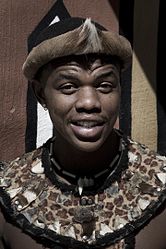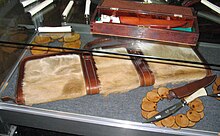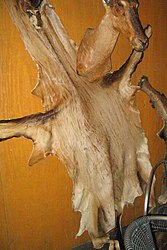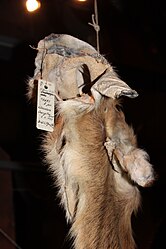Antelope fur
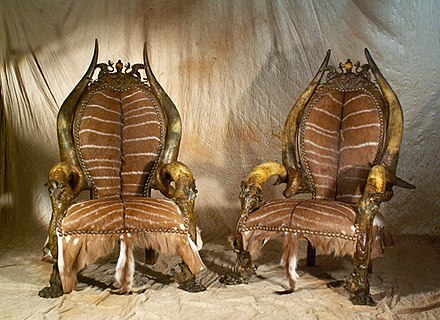
When it comes to fur processing, antelope skins are usually of minor importance, as the hair of the antelope species breaks very easily due to a lack of elasticity. Various antelopes are also kept on farms. The fur is mainly used for bags, trimmings and other small parts.
The non-scientific term antelope is generally understood to mean all horn-bearers that do not belong to the goat-like , which mainly includes sheep and goats, or to the cattle . Antelopes are therefore the duiker , the bovinae without the cattle, the hartebeest , the horse buck , the reduncinae (reedbuck, waterbuck and deer antelopes), the impala and the gazelle-like . The skins of the species-rich animal family from Africa and Southwest Asia are almost without exception as antelope or gazelle in the tobacco tradereferred to, including the skins of the springbok . In 1924, the English-speaking trade referred to antelope leather, tanned with suede for gloves, without hair as antelope, with hair as gazelle.
The antelope species that are mainly used for fur processing are the duiker and the small species, the dwarf antelopes , the most important of which is the greyhound antelope . Most Arabian antelope species are not suppliers of fur.
The number of species is so large that the differences in coat size and color are also quite significant. Some of the skins are almost one color, some with colorful stripes. Some species are vividly colored with pretty drawings, sometimes speckled black to silver-gray. The predominant colors are dark to light brown, reddish gray to yellowish gray, resembling roe deer or guinea fowl. The underside and the inside of the legs are often lighter than the body, light reddish or white to white-gray.
The hair is coarse, stiff and mostly very short. It lies close to the body, so that the fur often appears quite flat. The tubular hair has only a very thin layer of bark over the thicker marrow layer. The under hair is either completely absent or only sparsely developed. The durability coefficient for antelope skins is given as 5 to 10 percent.
History, trade
The skins come and did not only come from wild animals, the keeping of gazelles and antelopes as domestic animals can be proven from the ancient oriental civilizations and has continued into the present. Gazelle skins have been used by the local population as a decorative cover for seats and for other purposes since ancient times. African drums, like the djembé and the oprente , are often covered with antelope skin. In daily use, too, gazelle skins or leather were the main clothing material alongside goat skins and goatskin .
In the Ethiopian Hamar tribe , the antelope skin plays an essential role in the initiation rites of women, the acceptance into the community of adults. The procedure includes making a "binyere" from the skins of two dwarf antelopes, one male and one female. The two skins, twisted around a string, are first worn around the hips, later as a “pointed, bushy binyere” and then also worn around the neck by the married women. Substantial ritual procedures and incisive taboos are associated with this part.
In 1814, Schedel's lexicon of goods mentioned not only skins from African gazelles, but also those from Canada, which were often sold via England. The goods lexicon wrongly assigns the gazelles to the wild goats, but neither gazelles, antelopes nor wild goats occur in America, it should have been the skins of another ungulate species.
Several years before the First World War (1914 to 1918), larger batches of small duiker skins of various types that were processed into fur gloves came to the European market, around 30,000 to 40,000 pieces annually. A raw hide cost about 50 pfennigs. Around 1920 the skins were used to make women's jackets. However, this fashion stopped already three or four years later, “because the skins were very poorly durable and neither natural nor dyed looked particularly pretty. Sales therefore stalled completely ”. The Yemeni Aden was the main hub for the skins at that time . The skins of the other gazelles, like those of all other antelope species, were used exclusively for leather production.
Gazelle skins achieved "high esteem" in summer fur fashion in 1927 . For this they were sheared, shaped into “good-looking stripes” and made into summery coats. Purple-brown, natural-colored antelope skins, from which coats were made, were available in large quantities. However, the best goods were in short supply, most of the skins were damaged and bad. Philipp Manes , the chronicler of the fur industry who was murdered by the National Socialists, reports on Karl Bruhn, a very successful Berlin furrier, whose lure offers were famous in the shop windows: “It was of course mass-produced goods that he sold, but it was entirely in keeping with the taste of the Audience. He even took off the gazelle coat by the hundreds; he didn't mind if a piece was brought back after three days because it had left too much hair. "Manes continues:" Gazelle fashion ruled like an epidemic. The pretty skins were sold in bales, they were printed and dyed. But their glassy hair could not withstand any stress, and so this type of fur, which only caused trouble for all owners, fortunately soon disappeared from the industry. ”The attractive fur is still used, especially for bags that are less subject to wear than clothing.
- Traditional clothing made of antelope skin
Zulu with fur costume. Antelope fur painted with spots and wildcat tails . Shield made of (antelope?) Fur (2014)
processing

Since the use of the skins takes place the various antelope skin types usually for small items such as bags, trimmings, headgear and the like, mainly because of their short shelf life rarely as large assembly, the products from antelope skin are currently less of the fur manufacturing furriers worked, but rather of leather processing plants . Another problem with these types of fur, especially during processing to fur apparel that when sharp folding of the fur at the edges (fachsprachlich: edgefolding ) due to the flat, then projecting hair shine through the leather.
In 1928, when summer furs were up to date (which do not have such high demands on durability), the fur also found its way into a factory with working techniques of fur processors. As a special feature, it was recommended that “completely contrary to the usual habit of the furrier of aligning the sides not with a knife but with scissors”, so that the narrow-minded hair in the seams does not slide into one another unsightly. With a half- skin processing, the back of the fur ( grunting ) on the side of the fur, since the back is dark, the side is light again, a “very pretty and suddenly set in contrast effect can be achieved”.
The antelope skins used for clothing were usually dyed or printed with, for example, jaguar, leopard or ocelot patterns. The hair that was too long was shaved for it.
In 1965, the fur consumption for a skin table with 30 to 40 skins sufficient for an antelope or gazelle coat was given (so-called coat "body" ), whereby apparently very small gazelle skins were assumed. The calculation was based on a board with a length of 112 centimeters and an average width of 150 centimeters and an additional sleeve section. This corresponds roughly to a fur material for a slightly exhibited coat of clothing size 46 from 2014. The maximum and minimum fur numbers can result from the different sizes of the sexes of the animals, the age groups and their origin. Depending on the type of fur, the three factors have different effects.
The repairability of antelope pelts is indicated as "not recommended", and a fur remodeling of coats or jackets is not recommended. The edges quickly become bald.
- Modern products made from antelope skin
Opera singer Markus Schwendemann as Papageno in an antelope jacket (around 1986/87)
Men's hat ( Sydney , 2012)
Main antelope species that are suitable for fur processing
There is little information about which of the numerous forms of antelope were used in the tobacco industry. Below is a list of some of the species that are mainly suitable for fur processing.
Ducker
The smallest of the 29 currently known species of duiker are no larger than a hare, the largest can be larger than a deer. The length of the head body varies between 60 and 170 centimeters, depending on the species, and the tail measures around 5 to 10 centimeters. The coloration varies between species. Often the top is colored in a shade of brown, while the bottom is significantly lighter. Some species have yellowish or reddish shimmering fur, the zebra sugar got its name from its zebra-like striped pattern.
All species live in Africa south of the Sahara, and here mostly in the tropical rainforests of West and Central Africa.
- The blue duiker in southern Africa is the smallest species of antelope and has the largest distribution of antelopes. The top of the fur is slate gray to dark brown, but has a gray-blue sheen. The belly side and the underside of the tail are whitish. The short, bushy tail is black and white.
Blue duckers' skins came into international trade earlier.
gazelle
The fur of the gazelle is not quite the size of a deer or fallow deer. A noticeable feature is the 20 to 25 centimeter long snow-white hairs covered by skin folds, which are only visible in living animals when they are more active. The vivid, pretty coloring varies as well as size and build. Some of the skins are almost monochrome, others are colorfully striped. The coloring is lively with pretty drawings, some black to silver-gray speckled. The predominant colors are dark to light cinnamon brown, reddish gray to yellowish gray, similar to roe fowl or guinea fowl. The fur side and the inside of the legs are often lighter than the body: light reddish or white to white-gray. The fur length of this species-richest antelope is from 85 to 170 centimeters and a tail length of 15 to 30 centimeters.
The range of the gazelles covers the whole of Africa (excluding Madagascar ) and large parts of Asia (from the Arabian Peninsula to northern India and northern China).
The hairs of all the gazelle species listed below are short, smooth and close to close fitting. Little seems to be known about the hair changes of the different species of gazelle. Because of the lack of an undercoat, it probably runs inconspicuously over a longer period of time.
- Sömmerring Gazelle
The head body length of the Sömmerring gazelle is 123 to 153 centimeters, the tail length 18 to 21 centimeters. The coat is light yellow to reddish brown, the flank stripes are missing or only hinted at. The head is blackish-brown, under a white over-eye stripe that extends from the base of the horn to the snout, and under it, but only on the eye, another white stripe. The underside, the legs with the exception of a narrow outer stripe, and the mirror , which is widened at an angle towards the summit, are white.
The home of the species with five subspecies is East Africa ( Sudan , Ethiopia , Northern Somalia ). The Sömmerring gazelle is fully protected in national parks and reserves, outside of which there is partial protection.
- Dorcas Gazelle
The Dorcas gazelle is 85 to 105 centimeters long, and the tail is 15 to 20 centimeters long. The fur is sand-colored. The flank stripe is weak and reddish yellow-brown. The underside including the mirrors and the inside of the barrels are white. The head is reddish brown with a white stripe that runs above the eye from the base of the horn to the snout. There are tufts of long reddish brown hair on the knee.
The species with eight subspecies is at home in North Africa and Arabia. It is fully protected in national parks and reserves, outside of them there is partial protection.
- Red-fronted Gazelle
The body length of the male red-fronted gazelle is 110 to 120 centimeters, that of the female 105 to 110 centimeters, the tail length 19 to 25 or 15 to 20 centimeters. The coat color is strong red, sandy to yellowish-brown with a narrow, depending on the subspecies, brown to black stripe along the flanks and an also narrow, red-brownish "shadow stripe" below. The underside with the mirrors and the inside of the legs are pure white and sharply demarcated from the coloring on the upper side. The tail hairs are black. At the base of the tail the hair is short, on the remaining ¾ of its extent increasingly longer hair and tassel formation.
The home of the red-fronted gazelle with six subspecies is the savannahs of North Africa (southern edge to the Sahara), the hayling gazelle, a possible subspecies, lives in Ethiopia and eastern Sudan. The red-fronted gazelle is fully protected in national parks and reserves, outside of which there is partial protection. Red-fronted gazelles are also bred. The species is classified as endangered ("Vulnerable") by the IUCN - International Union for Conservation of Nature and Natural Resources .
- Thomson Gazelle
The Thomson gazelle is probably the most common type of gazelle. The head body length is 100 to 110 centimeters, the tail length 15 to 20 centimeters. It has a very contrasting pattern. The body is sandy to reddish yellow-brown. The wide flank strip is black and sharply demarcated against the white underside, the mirrors and the inside of the barrels are also white. The head is very colorful, because the forehead and the bridge of the nose are brown, the over-eye stripe white and the cheek stripe black.
The Thomson's gazelle is distributed over East Africa with three subspecies (Southeast Sudan, parts of Kenya, northern Tanzania). In national parks it is completely protected, outside it is under partial protection. The population of this species is not threatened.
- Giraffe gazelle
The giraffe gazelles get their name as leaf-eater from their slender neck, which is elongated for feeding. Male animals reach a head trunk length of 155 to 160 centimeters, female 140 to 155 centimeters. The tail length is 25 to 35 centimeters. The legs are also longer than the other, more ground-grazing gazelle species. The ears are very big. The coat color is light brown to dark brown ( Litocranius schateri ) or reddish brown ( Litocranius walleri ). A dark brown to purple-brown stripe extends from the height of the ears along the rear neck over the back (here 18 to 20 centimeters wide, gradually narrowing towards the rear) to the base of the tail. This two-tone coat on the top of the body is unique among gazelles. The striking contrast between the color of the saddle and the flank is often enhanced by a very light (to yellowish-white) intermediate stripe that merges into the flank color. The belly with the mirrors reaching to the base of the tail and the inside of the legs (thighs) are light yellow to white, the outside of the legs is nut brown. The neck of the male animals becomes lighter and lighter towards the head, sometimes yellowish-white, whereas in the females it is of an evenly light brownish color. The throat is white in both sexes. The hair on the white mirror is sparse, the hair on the knee and the tail tassel are significantly elongated.
The distribution of the giraffe gazelle with three subspecies extends in the savannah areas of East Africa from Southeast Sudan over parts of Kenya to northern Tanzania. It is fully protected in national parks in East Africa. Although the species is not very numerous, it is not considered threatened.
gnu
Wildebeest reach a head body length of up to about 2 meters. The coat color is different depending on the species (blue wildebeest,white tailed wildebeestand subspecies).
The coat of the blue wildebeest (East and South Africa) is brownish or bluish iridescent dark gray. There are dark horizontal stripes from the neck to the rear. A long, black mane covers the neck to the shoulders. A black beard grows on the throat. The black tail is reminiscent of a ponytail. At birth the calves are light reddish brown and have a darker face.
The white tailed wildebeest (southern Africa) is significantly smaller than the blue wildebeest. The coat color is blackish, the tail, similar to the ponytail, is whitish. The face is covered with bristle-like, protruding tufts, and long hairs grow on the neck and between the forelegs. A white mane with black tips extends from the neck to the shoulders.
Gnu skins are mostly used in leather processing. Fly whiskers were made from the long hairy tails.
impala

Impalas are colored fawn-brown at the top, the flanks are a little lighter in color. The lower abdomen, chest, throat, and chin are whitish. The rump is decorated with a vertical black stripe on both sides. The ankle joint and pastern, on the other hand, are black-brown, which is why this species is also called black heel antelope. A black tuft of hair grows above the hoof on each hind leg. The head is delicate, the eyes large and the ears narrow and pointed.
Their distribution area extends from Kenya and Uganda via Tanzania, Zambia, Mozambique and Zimbabwe to Botswana and northeastern South Africa, and the subspecies of the black-nosed impala lives in the border area of Angola and Namibia.
Impala skins came on the market in the 1960s.
The IUCN classifies the Impala as not endangered ("Least concern"); the black-nosed impala is considered endangered ("Vulnerable").
Springbok
The male springbok has a head body length of 125 to 150 centimeters, the female 120 to 145 centimeters. The tail length of the males is 20 to 32 centimeters, that of the females 20 to 27 centimeters. In appearance it resembles the Thomson gazelle . Like this one, it has a dark, red-brown stripe that separates the yellow-brown top from the white belly side. On the white head, a thin strip extends from the eyes to the upper corner of the mouth. The hair is close fitting, short and straight. The undercoat is absent or poorly developed. The hairs are elongated on the tip of the tail and on the back of the legs, and also slightly on the neck of the male. The longest (12 to 15 centimeters) and at the same time very stiff hair are in a fold of skin on the back of the back.
The home of the springbok with its three subspecies are the savannas of South Africa, Namibia, Angola and Botswana. Springbok are protected in reserves and enjoy hunting protection outside of them.
In 1930 a trade journal reported the first processing of springboks , namely into a coat that the Leipzig furrier Paul Büttner made at the special request of the customer . Until then, the skins for use in fur would not have been traded.
Greyhound antelope, Eritrean Dikdik
Particularly in Eritrea -based wind chime antelope is 52 to 67 centimeters long. The tail is between 3.5 and 5.5 inches long. Depending on the subspecies and habitat, the velvety soft fur has a reddish-brown to yellowish-brown, gray-bluish color on the back, which noticeably brightens towards the flanks. The neck is reddish gray and the legs are colored rusty red on the outside. Large parts of the back of the head, especially the cheek area, but also the neck and the sides of the neck are grayish in color. The tail is extremely short and ends in an inconspicuous tassel.
The species is listed in the IUCN Red List as not endangered ("Least Concern").
Numbers and facts
- In 1988 it was said about the attack of antelope pelts that exact numbers were not known. The fur was of little importance for trade at the time. The reason given was that, on the one hand, it would cause difficulties with processing and, on the other hand, it was almost always too flat for fur purposes.
- Skins of different antelope species
Hartebeest (hartebeest)
Male Kob (Waterbuck)
Horns and skins in the Natural History Museum Berlin
Remarks
- ↑ The specified comparative values ( coefficients ) are the result of comparative tests by furriers and tobacco shops with regard to the degree of apparent wear and tear. The figures are not unambiguous; in addition to the subjective observations of durability in practice, there are also influences from fur dressing and fur finishing as well as numerous other factors in each individual case . More precise information could only be determined on a scientific basis. The classification was made in stages of ten percent each, only the weakest species were given the value class of five to ten percent. The most durable types of fur according to practical experience were set to 100 percent.
- ↑ The information for a body was only given to make it easier to compare the types of fur. In fact, bodies were only made for small (up to about muskrat size ) and common types of fur, and also for pieces of fur . The following dimensions for a coat body were taken as a basis: body = height 112 cm, width below 160 cm, width above 140 cm, sleeves = 60 × 140 cm.
See also
Web links
Individual evidence
- ^ Norman Hertz: Shoes, Leather & Hides in Great Britain . Washington Government Printing Office, 1924 (English). Retrieved July 14, 2020.
- ↑ a b c antelope . In: Alexander Tuma: Pelz-Lexikon. Fur and rough goods. XVII. Tape. Publisher Alexander Tuma, Vienna 1949.
- ↑ a b c Fritz Schmidt : The book of the fur animals and fur . FC Mayer Verlag, Munich 1970, pp. 322-323.
- ↑ a b c d e f g Christian Franke, Johanna Kroll: Jury Fränkel ’s Rauchwaren-Handbuch 1988/89 . 10th revised and expanded edition. Rifra-Verlag, Murrhardt, S. 254-255 .
- ↑ Paul Schöps; H. Brauckhoff, K. Häse, Richard König , W. Straube-Daiber: The durability coefficients of fur skins. In: The fur trade. Volume XV, New Series, 1964, No. 2, Hermelin Verlag Dr. Paul Schöps, Berlin / Frankfurt am Main / Leipzig / Vienna, pp. 56–58.
- ↑ B. Brentjes: People and animals in the ancient Orient. In: The fur trade. Vol. XIX, new set, 1968/1969, No. 4, Hermelin-Verlag Dr. Paul Schöps, Berlin a. a., p. 33.
- ↑ B. Brentjes: To the fur costumes in African rituals. In: The fur trade. No. 4, new series, vol. XXI, 1972, Hermelin-Verlag Dr. Paul Schöps, Berlin a. a., p. 22.
- ↑ Jean Lydall: The story of Duka's necklace. In: Between appropriation and alienation: Ethnological ridge walks Festschrift for Karl-Heinz Kohl. Edited by Volker Gottowik, Holger Jebens, Editha Platte, Campus Verlag, 2009, ISBN 978-3-593-38873-1 , pp. 433–452.
- ^ D. Johann Heinrich Moritz Poppe: Johann Christian Schedels new and complete wares lexicon. Second part M to Z, fourth thoroughly improved edition. Verlag Carl Ludwig Brede, Offenbach am Mayn 1814, p. 393.
- ↑ Emil Brass : From the realm of fur . 2nd improved edition, publisher of the "Neue Pelzwaren-Zeitung and Kürschner-Zeitung", Berlin 1925, pp. 843–844.
- ^ A b Philipp Manes : The German fur industry and its associations 1900-1940, attempt at a story . Berlin 1941 Volume 2. Copy of the original manuscript, pp. 146–147 ( G. & C. Franke collection ).
- ↑ Alexander Tuma jun: The practice of the furrier . Published by Julius Springer, Vienna 1928, p. 128.
- ^ A b David G. Kaplan: World of Furs . Fairchield Publications, New York 1974, pp. 140, 155 (English).
- ↑ Paul Schöps u. a .: The material requirements for fur clothing. In: The fur trade. Vol. XVI / New Series 1965 No. 1, Hermelin-Verlag Dr. Paul Schöps, Berlin a. a., pp. 7-12.
- ↑ a b c d e f g h i j k l m n Heinrich Dathe , Paul Schöps u. a .: Fur Animal Atlas . Gustav Fischer Verlag, Jena 1986, pp. 289-298.
- ↑ Colin P. Groves , David M. Leslie Jr .: Family Bovidae (Hollwow-horned Ruminants). In: Don E. Wilson, Russell A. Mittermeier (eds.): Handbook of the Mammals of the World. Volume 2: Hooved Mammals. Lynx Edicions, Barcelona 2011, ISBN 978-84-96553-77-4 , p. 764.
- ↑ a b Springbok fur coat. In: Kürschner-Zeitung. Verlag Alexander Duncker, Leipzig September 1930.
- ↑ Gazella dorcas in the endangered Red List species the IUCN 2011. Posted by: IUCN SSC Antelope Specialist Group, 2008. Accessed July 26, 2011th

